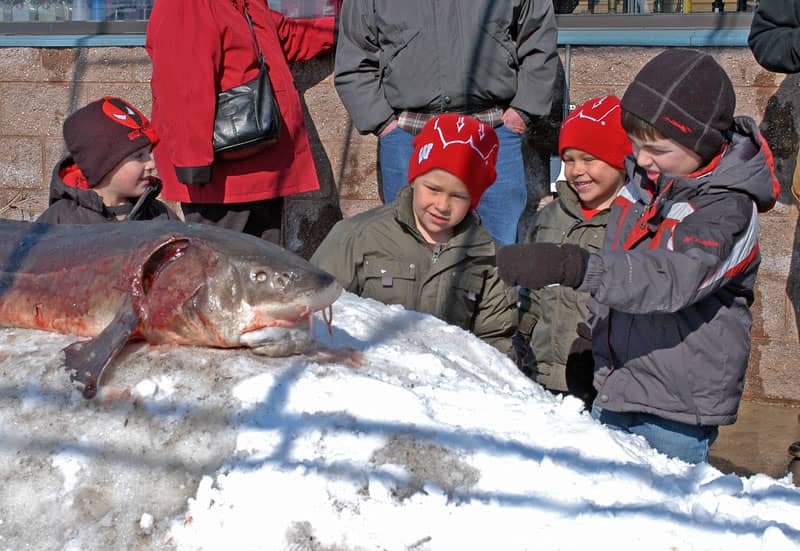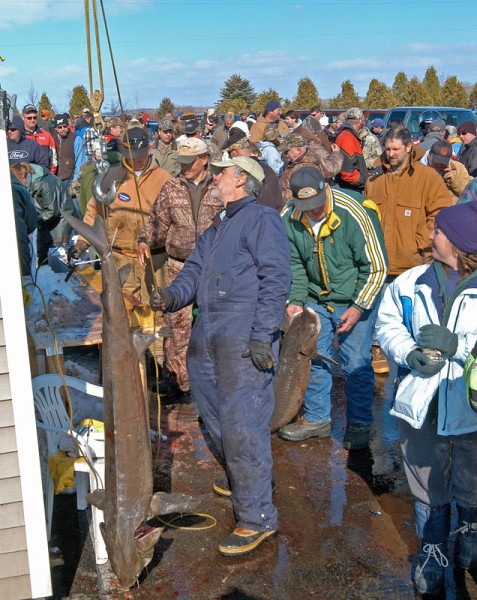Forage Shift Triggers Weight Loss for Wisconsin Lake Sturgeon
Patrick Durkin 03.16.15

Weight counts for much when fishermen discuss what they catch, maybe because they give little credibility to someone stretching their hands apart to show you a fish’s length.
Outstretched hands are equally unreliable when deer hunters show you the width of a buck’s rack, especially if they missed or didn’t shoot.
And you wondered where the expression “stretching the truth” originated?
Of course, anglers routinely overestimate weights, too, but they realize weights can vary depending on a fish’s diet, and by the amount of eggs a female is carrying when caught. Fish weights also vary by length—much as they do by height in humans—so if you see charts trying to make such correlations, realize they’re rough averages.
So, for all sorts of practical reasons, a fish’s weight sets the standard that anglers honor. It’s also what state fisheries agencies demand and verify before proclaiming state records, and it’s what the record books use to rank the top fish of each species.
And when it comes to weights, perhaps no fish population has its length/weight data and dietary habits as carefully documented as the lake sturgeon of the Lake Winnebago system in east-central Wisconsin. This massive waterway includes Winnebago, Wisconsin’s largest inland lake; portions of the Wolf and Fox rivers; and the “upriver” lakes of Poygan, Winneconne, and Butte des Morts.
During this winter’s spearing season for lake sturgeon, which ran eight days from February 14 to 21 before reaching its quota, spearers registered 2,158 fish. Of that total, 1,870 came from Lake Winnebago (87 percent) and 288 from the upriver lakes. Winnebago’s harvest was the lake’s sixth highest kill recorded from 1940 to 2015. The record season was 3,173 in 1995, but lasted 19 days.
Much of the talk this year, however, wasn’t the high kill, which averaged 208 per day compared to 1995’s 167 daily average. No, spearers noticed this year’s sturgeon were leaner than those speared in recent years.
For example, the season’s biggest fish—speared by Chad Cherney of De Pere, Wisconsin—weighed 137.5 pounds and measured 81.3 inches. When compared to the 25 heaviest speared sturgeon in Department of Natural Resources (DNR) records, Cherney’s fish was longer than 23 of them. Further, it’s 21.4 pounds lighter than the 25th fish on the list.
The heaviest sturgeon ever speared on Winnebago was a 212.2-pounder taken during the 2010 season. That behemoth measured 84.2 inches, the longest fish on the list, but not quite three inches longer than Cherney’s fish. In fact, only seven of Winnebago’s 25 heaviest sturgeon measured 80 inches or more, and only two were longer than Cherney’s fish.

So, what’s up with “Slim,” Cherney’s lanky sturgeon? Ryan Koenigs, the DNR’s senior fisheries biologist in Oshkosh and the Winnebago System’s sturgeon biologist, said the population remains healthy. The sturgeon weigh less this year, but they’re in good condition.
One could say they’re just on a low-fat, high-protein diet. Sturgeon in the Winnebago System typically pack on extra pounds when feasting on gizzard shad, a nonnative fish from the South that was seldom seen in these waters until the 1980s. Since then, the gizzard shad population has been up and down, often booming during warm-winter cycles and then collapsing during cold-winter cycles.
When sturgeon can feast on dead or dying gizzard shad, they gain weight. And when gizzard shad are in short supply, sturgeon must turn to their traditional food source, lake-fly larvae, or red worms, which live in the lake-bottom’s mud. Foraging for red worms simply isn’t as productive or efficient for calorie-intake as vacuuming for gizzard shad, a fatty fish high in calories.
Koenigs isn’t worried that the sturgeon’s weight loss will be a long-term liability. Shad populations will rebound quickly when conditions are favorable, and sturgeon will then shift their feeding focus back to these Southern invaders.
Koenigs reminds people that just because no fish made Winnebago’s all-time list this winter, it still produced big fish. In fact, a year ago, the Winnebago System added only one sturgeon to the top 25 list, a 77.1-inch, 161-pounder. Even so, the 2014 season produced a record 106 sturgeon weighing 100 pounds or more, with 95 coming from Winnebago and 11 from the upriver lakes.
If you doubt Koenigs, consider this: of the 25 heaviest sturgeon on the list, 23 have been speared since 2005, and eight of the 11 heaviest were speared during the past four years. He also notes that the biggest sturgeon the DNR has documented wasn’t speared. A DNR fisheries crew captured and tagged a 87.5-inch, 240-pound sturgeon in April 2012.
And that’s no fish story. It was witnessed by a gaggle of wader-wearing biologists, and they used a certified scale to check its weight.
Besides, none of them can stretch their hands 87.5 inches apart.
Top Sturgeon Weights, Lake Winnebago
Rank Length Weight Year
1 84.2 212.2 2010
2 79.5 188 2004
3 80.2 185 2011
4 79 180 1953
5 79.6 179.8 2012
6 80 179 2013
7 78.5 175.3 2012
8 76.9 172.7 2011
9 78 172 2008
10 83 171.3 2010
11 75.6 171.3 2011
12 80.7 169.3 2011
13 80.8 168.8 2009
14 77.3 168.3 2011
15 76.7 164.7 2010
16 78.5 164 2005
17 73.6 163.5 2011
18 78.5 162.5 2008
19 78.5 161 2008
20 76 161 2008
21 80 161 2008
22 77.1 161 2014
23 77.1 159.4 2010
24 75 159 1986
25 77 158.9 2011
Patrick Durkin is a freelance writer who covers outdoors recreation for the Wisconsin Outdoor News. Write to him at 721 Wesley St., Waupaca, WI 54981; or by e-mail at patrickdurkin@charter.net.

